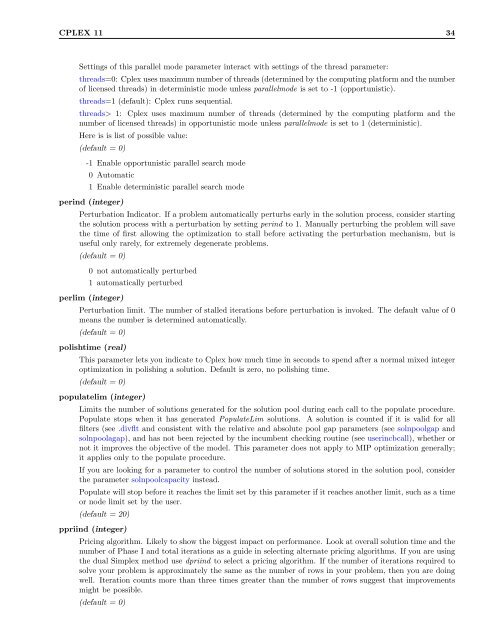You also want an ePaper? Increase the reach of your titles
YUMPU automatically turns print PDFs into web optimized ePapers that Google loves.
<strong>CPLEX</strong> <strong>11</strong> 34Settings of this parallel mode parameter interact with settings of the thread parameter:threads=0: Cplex uses maximum number of threads (determined by the computing platform and the numberof licensed threads) in deterministic mode unless parallelmode is set to -1 (opportunistic).threads=1 (default): Cplex runs sequential.threads> 1: Cplex uses maximum number of threads (determined by the computing platform and thenumber of licensed threads) in opportunistic mode unless parallelmode is set to 1 (deterministic).Here is is list of possible value:(default = 0)-1 Enable opportunistic parallel search mode0 Automatic1 Enable deterministic parallel search modeperind (integer)Perturbation Indicator. If a problem automatically perturbs early in the solution process, consider startingthe solution process with a perturbation by setting perind to 1. Manually perturbing the problem will savethe time of first allowing the optimization to stall before activating the perturbation mechanism, but isuseful only rarely, for extremely degenerate problems.(default = 0)0 not automatically perturbed1 automatically perturbedperlim (integer)Perturbation limit. The number of stalled iterations before perturbation is invoked. The default value of 0means the number is determined automatically.(default = 0)polishtime (real)This parameter lets you indicate to Cplex how much time in seconds to spend after a normal mixed integeroptimization in polishing a solution. Default is zero, no polishing time.(default = 0)populatelim (integer)Limits the number of solutions generated for the solution pool during each call to the populate procedure.Populate stops when it has generated PopulateLim solutions. A solution is counted if it is valid for allfilters (see .divflt and consistent with the relative and absolute pool gap parameters (see solnpoolgap andsolnpoolagap), and has not been rejected by the incumbent checking routine (see userincbcall), whether ornot it improves the objective of the model. This parameter does not apply to MIP optimization generally;it applies only to the populate procedure.If you are looking for a parameter to control the number of solutions stored in the solution pool, considerthe parameter solnpoolcapacity instead.Populate will stop before it reaches the limit set by this parameter if it reaches another limit, such as a timeor node limit set by the user.(default = 20)ppriind (integer)Pricing algorithm. Likely to show the biggest impact on performance. Look at overall solution time and thenumber of Phase I and total iterations as a guide in selecting alternate pricing algorithms. If you are usingthe dual Simplex method use dpriind to select a pricing algorithm. If the number of iterations required tosolve your problem is approximately the same as the number of rows in your problem, then you are doingwell. Iteration counts more than three times greater than the number of rows suggest that improvementsmight be possible.(default = 0)
















